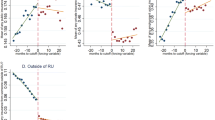Abstract
This paper provides new estimates of the relationship between health insurance coverage and health status of young adults using the confidential version of the National Longitudinal Survey of Youth, 1997 Cohort (NLSY97). Using a regression discontinuity design, I find that approximately 6 % of young adults lose their health insurance coverage once they turn 19. However, in contrast to the findings from the recent literature, the effect of this discrete change in health insurance coverage on self-reported health status of young adults is quite limited and often statistically insignificant.

Similar content being viewed by others
Notes
Suppose that one has information only on the birth month and year of each respondent and the interview date. Then, treatment and control groups cannot be precisely identified. For instance, a respondent who was born on January 1, 1984 and interviewed on January 30, 2003 will be mistakenly placed in the control group (those who are 19 and younger). But, this respondent is actually in the treatment group since she is 29 days older than 19 at the time of the interview. Furthermore, by definition, the RD approach estimates the local treatment effect, which calls for a very detailed information around the age-19 cutoff.
The respondents of the NLSY97 were asked about their health insurance coverage starting from the 2002 wave. Due to the longitudinal nature of the NLSY97, the respondents get older over time and all the respondents are 20 years old or older after the 2004 wave. Since the RD analysis in this paper uses data for those who are at most one year younger or older than the cutoff age of 19, the sample is restricted to the 2002, 2003, and 2004 waves of the NLSY97.
Using smaller bandwidths will reduce the sample size and affect the standard errors. However, I also estimate similar models for smaller bandwidths of 240 and 180 days. The results from these models are also statistically insignificant which suggest that self reported health status does not exhibit a discrete change at age 19. Although not reported here, these results are available from the author upon request.
It is also possible to estimate similar RD models using kernel-weighted non-parametric local linear regressions with a triangle kernel. The results from these non-parametric models are comparable to those from the parametric models. The results from the non-parametric models are not reported due to space constraints but are available from the author upon request.
Since several observations are missing for household income and employment status, I use dummy variables controlling for the ”missing” observations for these set of covariates. The descriptions and summary statistics of the control variables are presented in Appendix 1.
Timmins (2012) provides a simple explanation of this relationship.
References
Anderson, M., Dobkin, C., & Gross, T. (2012). The effect of health insurance coverage on the use of medical services. American Economic Journal: Economic Policy, 4, 1–27.
Antwi, Y. A., Moriya, A., & Simon, K. (2013). Effects of federal policy to insure young adults: Evidence from the 2010 Affordable Care Act’s dependent-coverage mandate. American Economic Journal: Economic Policy, 5, 1–28.
Barbaresco, S., Courtemanche, C. J., & Qi, Y. (2015). Impacts of the Affordable Care Act dependent coverage provision on health-related outcomes of young adults. Journal of Health Economics, 40, 54–68.
Cardella, E., & Depew, B. (2014). The effect of health insurance coverage on the reported health of young adults. Economics Letters, 124, 406–410.
Easterlin, R. A. (2003). Explaining happiness. Proceedings of the National Academy of Sciences, 100, 11176–11183.
Finkelstein, E., et al. (2012). The Oregon Health insurance experiment: Evidence from the first year. Quarterly Journal of Economics, 127, 1057–1106.
Imbens, G., & Lemieux, T. (2008). Regression discontinuity designs: A guide to practice. Journal of Econometrics, 142, 615–635.
Lee, D. S., & Lemieux, T. (2009). Regression discontinuity designs in economics, NBER Working Paper No. 02138.
Matilla, M., Söderlund, P., Wass, H., & Rapeli, L. (2013). Healthy voting: The effect of self-reported health on turnout in 30 countries. Electoral Studies, 32, 886–891.
Smith, J. P. (1999). Healthy bodies an thick wallets: The dual relation between health and economic status. Journal of Economic Perspectives, 13, 145–166.
Timmins, L. (2012). How much does health insurance matter for young adults? Its role on primary medical care consumption, Unpublished Manuscript, Department of Economics, University of British Columbia.
Yörük, B. K. (2014). Does giving to charity lead to better health? Evidence from tax subsidies for charitable giving. Journal of Economic Psychology, 45, 71–83.
Yörük, B. K. (2015). Health insurance coverage and risky health behaviors among young adults, CESifo Working Paper No. 5495.
Acknowledgments
This paper uses confidential data provided by Bureau of Labor Statistics (BLS). The views expressed in this paper are those of the author and do not necessarily reflect those of the BLS.
Author information
Authors and Affiliations
Corresponding author
Appendices
Appendix 1
See Table 3.
Appendix 2
See Table 4.
Appendix 3
See Fig. 2.
Change in selected control variables at the 19th birthday. a Ln(income), b marital status, c family size, d prob. of being a student, e prob. of being a high school grad, f employment status. Notes Mean of the selected control variables for 30 days intervals are plotted. The solid lines are a first-order polynomial fitted on individual observations on either side of the age-19 cutoff
Rights and permissions
About this article
Cite this article
Yörük, B.K. Health insurance coverage and self-reported health: new estimates from the NLSY97. Int J Health Econ Manag. 16, 285–295 (2016). https://doi.org/10.1007/s10754-016-9189-1
Received:
Accepted:
Published:
Issue Date:
DOI: https://doi.org/10.1007/s10754-016-9189-1





